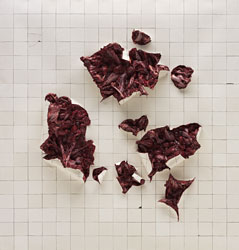2.5
Senior Years Activity
Beyond the Surface

Lucio FONTANA
Argentinian/Italian 1899–1968
Concetto spaziale, Attese (Spatial Concepts) 1965
water-based paint on canvas, white
130 x 97 cm
Solomon R. Guggenheim Foundation
Gift, Fondazione Lucio Fontana
© Courtesy of Fondazione Lucio Fontana
88.3590

Adriana VAREJÃO
Brazilian 1964–
Folds 2 2003
oil on canvas over aluminium, mounted to wood with oil-painted polyurethane
240.7 x 230.2 x 40 cm
Solomon R. Guggenheim Museum, New York
Purchased with funds contributed by the International Director’s Council and Executive Committee Members: Ruth Baum, Edythe Broad, Elaine Terner Cooper, Dimitris Daskalopoulos, Harry David, Gail May Engelberg, Shirley Fiterman, Nicki Harris, Dakis Joannou, Rachel Lehmann, Linda Macklowe, Peter Norton, Tonino Perna, Elizabeth Richebourg Rea, Mortimer D. A. Sackler, Simonetta Seragnoli, David Teiger, and Elliot K. Wolk
© Adriana Varejão, courtesy of Lehmann Maupin Gallery, New York
2003.77
For |
Senior Years Students |
Curriculum |
VCE Art/Studio Arts |
Aim |
To consider the role of a curator in designing an exhibition. |
Preparation |
To do this activity you will need to:
|
Individual Task |
Imagine you are the curator of an exhibition in a large Australian public gallery that displays modern and contemporary art. You are to curate an exhibition entitled "Beyond the Surface". Would you want to include these works by Adriana Varejão and Lucio Fontana? Give reasons for your point of view. In your response refer to the ideas raised in the preceding description of the work and at least two of the commentaries. Also refer to the two images reproduced above. Consider your response after viewing the original. Commentary 1Adriana Varejão (b. 1964, Rio de Janeiro) is immersed in the complex cultural history of her native Brazil. For Varejão, works of art are vital, living organisms, and her sculptural, relief-like paintings are meant to be read as bodies, both individual and social. In Folds 2 2003, the pure, white tile 'skin' ruptures, exposing the life-blood and organs that usually remain concealed beneath the surface. Commentary 2Lucio Fontana has not made real art he has just slashed a canvas. Good art, in my opinion, includes skilfully hand painted landscapes, still lives and portraits, subjects that ordinary people can relate to. This so-called artwork is more like vandalism. It promotes destructive attitudes. Why even call this art? How can the spending of public money be justified? Adriana Varejão's Folds 2 is just as senseless to me as Fontana's work, but even more horrible and ugly; her subject matter of oozing meat is unnecessarily gory. The use of blood and guts are revolting and tasteless. Art should inspire – not ooze or slash. Commentary 3How refreshing it is that both well known artists Fontana and Varejão produce work that is so innovative, edgy, energetic and experimental. In his time, Fontana's radical slashing of the canvas was a decisive move beyond the tradition of narrative in painting. Varejão's contemporary perspective on her country's troubled history is creative, confronting and honest. The gallery has the freedom to bring challenging international ideas to the Australian public from cutting edge artists from across the world. If you take the time to experience the works firsthand, and then take the next step to understand their place in art history, you'll be richly rewarded. |